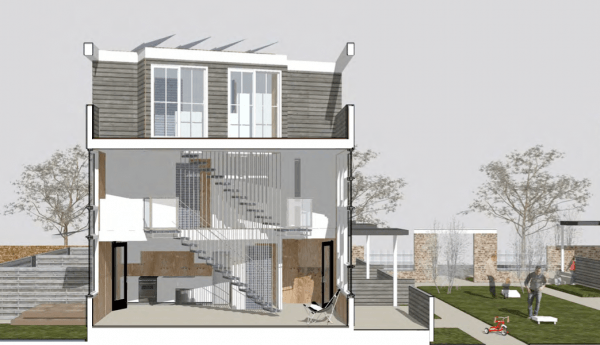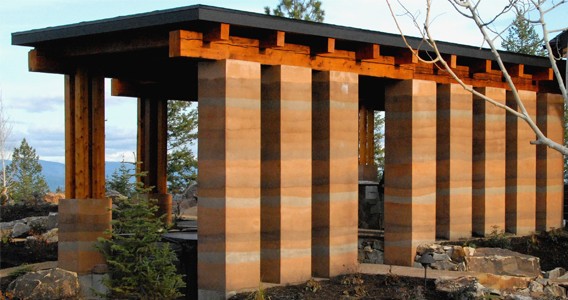Fans of the HBO series The Wire know that inner-city Baltimore is a land of narrow three-story row houses, many of them boarded up, interpersed with vacant land where similar row houses once stood. Fittingly, narrow three-story row houses to fill some of that vacant land were specified in a recent contest for low-carbon-footprint designs.
The US Forest Service and APA, The Engineered Wood trade association, sponsored this Carbon Challenge and concurrent but very different ones in Providence (low-budget four-bedroom houses) and in Florida (suburbia homes affecting styles like Arts-and-crafts and Mediterranean).

I really admire the judges for being good sports. They got the contest’s rules hurled back in their faces by several contestants—whom they then rewarded with prizes.
The team from RM Sovich Architecture told them that the house the rules called for—1,750 to 2,500 square feet sleeping three adult roommates—is way too big to be called low-carbon. “The best way to reduce carbon footprints,” they wrote, “is to reduce the overall quantity of construction/space used per person.” Comparing themselves to Le Corbusier, who drew up 660-sq-ft units to sleep five artisans, they refused to design more than 1,260 sq. ft. for this contest. Their white cubist units, the most contemporary-looking of the six winning designs and the least row-house-like, won in the “best curb appeal” category.
A subversive collective of four theorists objected even more radically. They insisted that the proposed site must remain unbuilt because it is the home of the Baltimore Lightning, a neighborhood teen football team. In page after page of demographic data showing this as one of the most impoverished blocks in the city, they make a strong case that the neighbors need the football field more than they need new buildings—especially ones that they can’t possibly afford. This gang of four designed the site to center on Lightning Field, but compromised enough to draw their idea of row houses on other lots nearby. They argue that the houses should be smaller and cheaper than the contest called for, and should accommodate families. The judges gave them a Special Award for Best Social Statement.
(Key detail: guided tours of Baltimore for fans of The Wire identified this exact block as the show’s “Body-more Murdaland.”)
Grand Prize winner Phillip Jones rebelled in subtler but profound fashion. For a contest “designed to raise awareness of the environmental benefits of wood construction,” he submitted a proposal to build his main walls out of rammed earth, an ancient material that minimizes the use of wood (and probably improves on wood in carbon terms). The judges cited the material’s contribution to lowering the carbon footprint.
Oversimplifying just a bit, Jones’s “stabilized insulated rammed earth” resembles cast concrete more than any other familiar wall material, but is more attractive and lower-carbon because it contains much less Portland cement. It’s also sound-absorbing, non-toxic, abundant, biodegradable, and it helps maintain a nice moderate indoor humidity.

Earth can be rammed without any cement. That was the norm for millenia, but the product is much more moisture-resistant and stronger when “stabilized” with cement. Some complain that adding cement blows all the carbon advantages of rammed earth, but the Athena life-cycle assessment software must have confirmed that the cement stabilizer was minimal enough to preserve an admirable carbon footprint. Go ahead and enjoy your unstabilized walls in Santa Fe (or use blood for the stabilizer, as the ancients did), but here in rainy Portland I think I’ll add a dash of cement.
What about the “earth?” Ordinary subsoil. Sometimes the soil on the site can be used. You have to make sure of the right proportions of moisture, clay, sand, and a little gravel. You build temporary wooden forms (as you would for pouring concrete), fill them with layers of moist earth, and forcefully ram each layer to about half its former bulk using pneumatic tampers.
“Insulated?” Well, thick concrete walls are a staple of passive solar design. They insulate and they also hold the day’s heat and release it at night. Rammed earth shares these traits. But who says you can’t improve on it by adding a layer of rigid foam insulation?
Jones’s “stabilized insulated rammed earth” walls are 12 inches thick. The acronymic SIREWALL, Inc. likes 18 to 24 inches, with 4 inches of foam in the center. The company’s website is a great source on this futuristic/ancient material, which I have to say intrigues this writer all to pieces.